BY SIMON SOON
[Published in C-Arts Volume 16, 2010. Minor errors may have been corrected.]
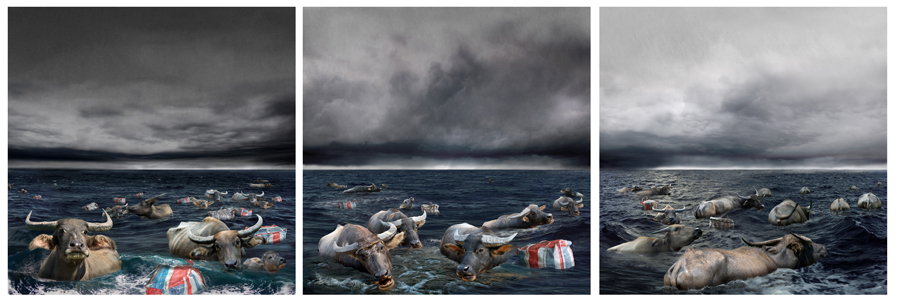 A Rousing Account of Migration in the Language of the Sea
A Rousing Account of Migration in the Language of the Sea
It is a somewhat unique if not anomalous phenomenon among artists from Southeast Asia that there exists in Malaysia and Singapore a particular breed of artists who have adopted a region-wide sensibility, a scope and awareness larger than their immediate national identity and concern. This trend finds little parallel with artists practicing in other parts of the region.
Examples of these include the Singapore and Malaya-based Nanyang school of painters who sought to capture the tropical landscape and culture through a localized form of cubist/primitivist expression, expressionist Latiff Mohidin’s construction of a symbolic motif that represents the spirit of Southeast Asia in his Pago-Pago series, Redza Piyadasa and Sulaiman Esa’s promulgation of a Pan-Asian mystical approach to art making in their 1974 exhibition Towards a Mystical Reality, The Artists Village’s wilful engagement with performance artists throughout the region since the mid-nineties. Yee I-Lann’s practice articulates a similar, long-realised conclusion that solely addressing the cultural make-up of specific nation-states of Southeast Asia is an untenable lens for reaching into the socio-historical psyche of the region.
This may have stemmed from the marginality and seeming constructedness of modern Malaysia and Singapore. Buffeted by larger countries with a seemingly much more confident assertion of their national and historical identities, Malaysia and Singapore seem newly-minted. Thailand, Indonesia, the Philippines, Vietnam, all had a sense of historical destiny that has been much more successfully moulded into a language of national aspiration. Whereas the multi-cultural realities of a federated Malaysia and the Chinese immigrant community that makes up the majority of the Singapore population germinated a pocket stream of awareness that its immediate borders are never as fixed and as certain as we imagine them to be. For less than a century ago, the world of its denizens and traffic of its cultures, like the buffaloes that wade across the dark waters in A Rousing Account of Migration in the Language of the Sea, weaved a different pattern of migration and mobility.
Therefore one of the most important statements made in her most recent solo exhibition Boogeyman is a cartographical exercise. In Fluid World, the erased land mass creates a relief that places the sea at the centre of its narrative. Instead of thinking of oceans as dividing bodies of water, they are seen as conduits of traffic. The world in which Boogeyman and its most dramatic element exist is not found on dry land but on the waterways that brought different cultures, ideas and economies into contact.
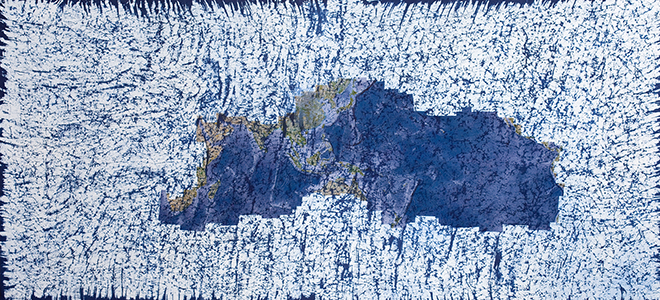 Fluid World
Fluid World
Boogeyman can be seen as a culmination of the artist’s long-held fascination with the socio-political history of Southeast Asia, its shifting borders, maritime traffic, shared heritage and political structures. But like the dark grey clouds that loom across the seascapes where much of Boogeyman’s acrobatic seafarers are set, the series marks a turn towards a darker and more ominous narrative compared to Yee I-lann’s previous digital photographs.
The term ‘boogeyman’ describes a mythical monster in popular imagination, a shapeless creature that jumps out of the closet at night to frighten little children. One popular argument for the origin of the term associates it with the ‘Bugis-Man’, a mercenary group of sea warriors of Bugis ethnic origin who roamed local seas raiding foreign trade ships during the early years of European trade in Southeast Asia. The work Empire of Privateers and their Glorious Ventures illustrates their seafaring careers as privateers of the nobles or Orang Besar; they were swords for hire, so to speak, a resistance force available to combat against European incursion and the disruption of local trade networks.
For the Europeans, this high sea pillaging was tantamount to piracy, and the term bogeyman found its way into popular usage as an expression of irrational fear. Yee I-Lann’s Boogeyman is therefore that imaginary object of fear that seethes beneath the apparent calm and control over a particular situation. It is on its most local level a response to the sloganeering campaigns that have shaped societal values. In Malaysia for example, concept of ‘bangsa Malaysia’ or ‘1Malaysia’ aspire to project a kind of mythic unity that glosses over its apparent lack. The boogeyman evokes a spectral resistance that unmasks the historical power structure sited in this geography, its contemporary resonance and how they play out in the maritime waters, which transact the volatile, and shifting power bases across the region.
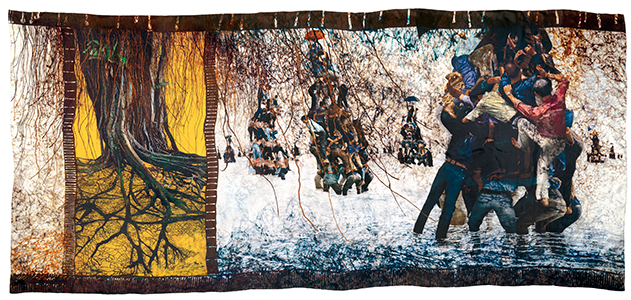 Kain Panjang with Parasitic Kepala
Kain Panjang with Parasitic Kepala
Central to Boogeyman is the Orang Besar series, which casts the modern democratic processes of country in light of its traditional power structure. The Orang Besar, translated as “the big man” (also interchangeable with the term Orang Kaya or the rich man) stood as the mediating agent between the apex (represented by the Sultan) and the common man. The measure of his influence or power was not an account of his worldly wealth, but rather the number of persons dependent on him. This control over a sizeable population gave him a prized labour force through which he could realise various undertakings and seek a political base or leverage against the competitive intrigues of the court.
This traditional system of measuring political power in terms of headcounts flavours democracy in the region today. Looking at the unstable clusters of human pyramid that narrates Kain Panjang with Parasitic Kepala, one draws parallels between the huddled formation and the kind of volatile and shaky alliances that spill over into today’s politics of patronage. The question of patronage is something that reverberates strongly in Malaysian culture today and I-Lann’s kitschy homage/satire of this culture plays out in the YB series, tightly cropped photographs of flower brooches that are normally pinned onto the shirt of important politicians who attend a particular event in the capacity of a VIP. The florid and arabesque portraits of different plant lives seem to suggest an organic representation of excesses. There is an element of ostentation and camp in these photos when viewed in the context of how patronage has continued to exist in Malaysian society.
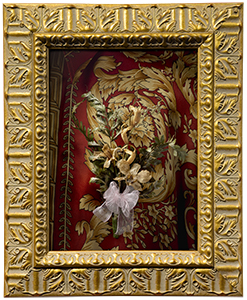 YB
YB
But what makes the Orang Besar series a remarkable leap from the vocabulary of Yee I-Lann’s previous exploration of digital photographs is her ability to combine the former with batik. As a textile tradition unique to the region, the batik medium carries a potentially subaltern agency. Because batik production is traditionally recognised as a women’s craft, this inscription lends a female commentary that is able to throw into relief the negotiation of power from an alternative vantage point.
More importantly, this method of storytelling draws upon the narrativity of batik, which is seldom acknowledged or recognised. The popular assumption that visual patterns of the batik are solely ornamental fails to acknowledge the coded vocabulary that batik carries. Traditionally, each motif symbolises specific events in Javanese courtly life – war, birth, marriage, death. Though we also find how in its modern usage, such as in the badminton racket which became a motif to commemorate Malaysia’s victory in the Thomas Cup, how batik documents our modernity.
It is also through batik’s very materiality, its measurement of length that I-Lann is able to rechart her horizon in sartorial terms. Curator Beverly Yong, in an article for PhotoArtAsia magazine in 2008, traced the genesis of the horizon to I-Lann’s Malaysiana series. In these works, the artist took photographs from the archive of a photo studio and arranged them according to typologies that celebrated various rites of passages in Malaysia. The grid-like effect of her arrangement achieved a kind of uniformity in the way the backdrop, the linoleum floor and the baseboard connect and unify all these different studio portraits, transforming seemingly private moments into a national narrative. This continuity draws a horizontal connection among the individual photos.
I-Lann was then able to fully explore this concept during her residency in South Australia, returning to produce the Horizon series, which chronicles the Malaysian dream of the then popular slogan Vision 2020 of former Prime Minister Mahathir Mohammad against the vast expanse of the Australian landscape. This was followed by an alternative account to Malaysian and Filipino narrative of their territories through the staging of the Sulu region’s socio-cultural drama in her sequel, Sulu Stories.
Boogeyman takes off from her more recent development beginning with the Kinabalu series made in 2007. Mount Kinabalu, the highest mountain in Southeast Asia, stands as a fixture in the dramatically changing environment around it. In all three photographic works, which comprise the series, the mountain looms over its subjects – a legendary female deity (Huminodun), a family portrait (Anak Negeri) and a dystopic vision of the Malaysian state (Kopivosian). Each of these photographs form a horizon belt surrounds the mountain, offering in this instance a parallactic view of her state, revising her previous notion of the horizon as an infinite lateral spread.
 Kopivosian
Kopivosian
This act of encircling, further developed in I-Lann’s use of the batik in Orang Besar, also indexes the body politics that come to play within her photographic tableau. As an article of fashion, it wraps around the body enveloping the wearer within its narrative. It seems that in this instance that the spatial coordinates through which the horizon has been utilized in I-Lann’s practice is atomised onto a level that is sartorially personal.
Perhaps a new element of I-Lann’s exploration of the horizon finds its most powerful expression in the Malaysia Day Commemorative Plates. Here the horizon is no longer a visual motif but a conceptual cue. Different localities are drawn together by the historical date 16 September 1963 carved on each of the four pewter plate which bear the signatories of the four territories (Malaya, Singapore, Sabah and Sarawak) coming together to form Malaysia. The historic date marks and links one territory to another, mapping the partnership of autonomous bodies in giving birth to a new country. It is also here that we come to see what the horizon is for the artist, it is that visual and conceptual ‘sight’ that is able to connect, project and draw fragments of our culture in order to make sense of it from a vantage point that is able to look out far ahead, both spatially and temporally.
Because of this, one gets the sense that the series was able to push the meaning of ‘Malaysia’ toward a larger discourse, one that recognises the fluidity of nationalist aspiration and the historical accidents and shifts that shape it. It becomes poignant when one realises that Singapore was once a partner in this dream.
The Malaysia Day Commemorative Plates therefore subvert just as much as they celebrate the newly announced holiday in Malaysia. The country has never celebrated its foundation in the past 47 years, favouring instead Malaya’s independence from the British in 1957. The year 2010 marks the first time the birth of the nation was celebrated on a national scale. It is on this day that I-Lann chose to open her exhibition, affirming not only her solidarity with this recognition but also releasing through this series of work some glimmer of optimism in an otherwise dark and haunting exhibition marking a small victory for the Boogeyman, for those resistance fighters in us.
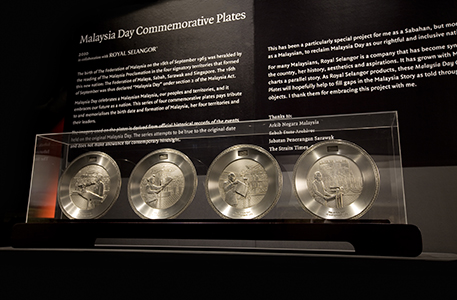 Malaysia Day Commemorative Plates
Malaysia Day Commemorative Plates
Simon Soon is currently completing a PhD in art history at the University of Sydney. His research focuses on Southeast Asia modern and contemporary art.
